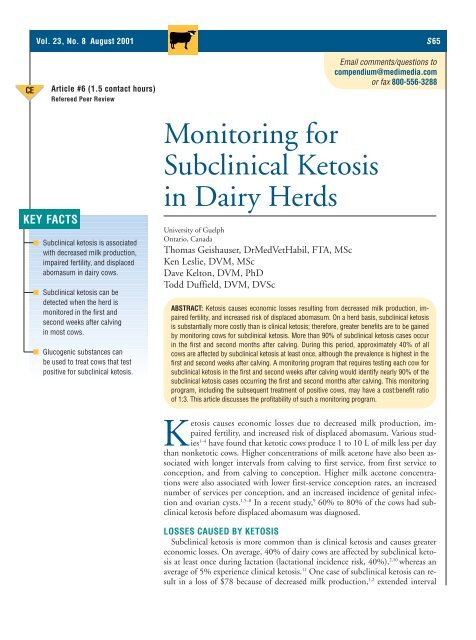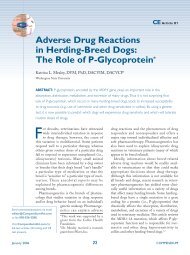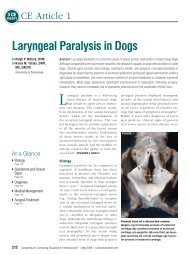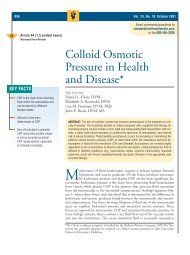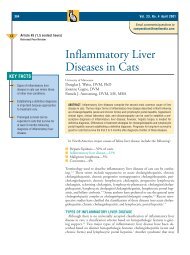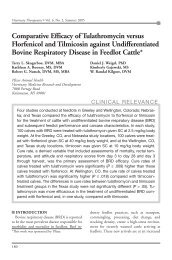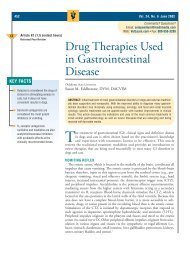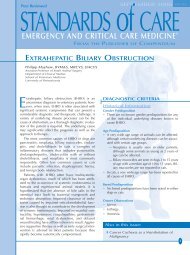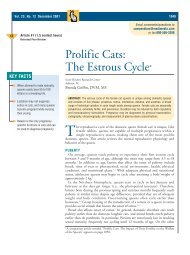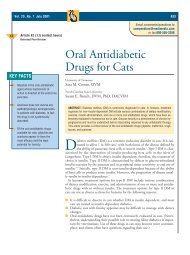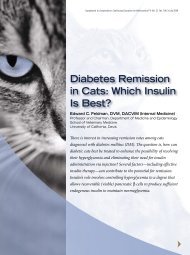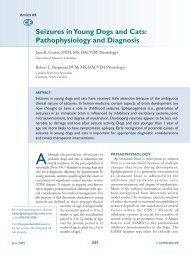CEARTICLE #6 CE TEST - Vetlearn.com
CEARTICLE #6 CE TEST - Vetlearn.com
CEARTICLE #6 CE TEST - Vetlearn.com
You also want an ePaper? Increase the reach of your titles
YUMPU automatically turns print PDFs into web optimized ePapers that Google loves.
<strong>CE</strong><br />
Vol. 23, No. 8 August 2001 S65<br />
Article <strong>#6</strong> (1.5 contact hours)<br />
Refereed Peer Review<br />
KEY FACTS<br />
■ Subclinical ketosis is associated<br />
with decreased milk production,<br />
impaired fertility, and displaced<br />
abomasum in dairy cows.<br />
■ Subclinical ketosis can be<br />
detected when the herd is<br />
monitored in the first and<br />
second weeks after calving<br />
in most cows.<br />
■ Glucogenic substances can<br />
be used to treat cows that test<br />
positive for subclinical ketosis.<br />
Monitoring for<br />
Subclinical Ketosis<br />
in Dairy Herds<br />
University of Guelph<br />
Ontario, Canada<br />
Thomas Geishauser, DrMedVetHabil, FTA, MSc<br />
Ken Leslie, DVM, MSc<br />
Dave Kelton, DVM, PhD<br />
Todd Duffield, DVM, DVSc<br />
Email <strong>com</strong>ments/questions to<br />
<strong>com</strong>pendium@medimedia.<strong>com</strong><br />
or fax 800-556-3288<br />
ABSTRACT: Ketosis causes economic losses resulting from decreased milk production, impaired<br />
fertility, and increased risk of displaced abomasum. On a herd basis, subclinical ketosis<br />
is substantially more costly than is clinical ketosis; therefore, greater benefits are to be gained<br />
by monitoring cows for subclinical ketosis. More than 90% of subclinical ketosis cases occur<br />
in the first and second months after calving. During this period, approximately 40% of all<br />
cows are affected by subclinical ketosis at least once, although the prevalence is highest in the<br />
first and second weeks after calving. A monitoring program that requires testing each cow for<br />
subclinical ketosis in the first and second weeks after calving would identify nearly 90% of the<br />
subclinical ketosis cases occurring the first and second months after calving. This monitoring<br />
program, including the subsequent treatment of positive cows, may have a cost:benefit ratio<br />
of 1:3. This article discusses the profitability of such a monitoring program.<br />
Ketosis causes economic losses due to decreased milk production, impaired<br />
fertility, and increased risk of displaced abomasum. Various studies<br />
1–4 have found that ketotic cows produce 1 to 10 L of milk less per day<br />
than nonketotic cows. Higher concentrations of milk acetone have also been associated<br />
with longer intervals from calving to first service, from first service to<br />
conception, and from calving to conception. Higher milk acetone concentrations<br />
were also associated with lower first-service conception rates, an increased<br />
number of services per conception, and an increased incidence of genital infection<br />
and ovarian cysts. 1,5–8 In a recent study, 9 60% to 80% of the cows had subclinical<br />
ketosis before displaced abomasum was diagnosed.<br />
LOSSES CAUSED BY KETOSIS<br />
Subclinical ketosis is more <strong>com</strong>mon than is clinical ketosis and causes greater<br />
economic losses. On average, 40% of dairy cows are affected by subclinical ketosis<br />
at least once during lactation (lactational incidence risk, 40%), 2,10 whereas an<br />
average of 5% experience clinical ketosis. 11 One case of subclinical ketosis can result<br />
in a loss of $78 because of decreased milk production, 1,2 extended interval
S66 Food Animal Compendium August 2001<br />
TABLE 1<br />
Estimated Losses Resulting from<br />
Subclinical Ketosis in One Cow<br />
Production Losses Money Lost<br />
2 L of milk production less per day for $8<br />
2 wk ($0.30/L)<br />
Calving-to-conception interval extended $28<br />
for 2 wk 8 ($2/day)<br />
Threefold increased risk of clinical ketosis 2,a $22<br />
Threefold increased risk of displaced $20<br />
abomasum 9,b<br />
Total $78<br />
a Given an average lactational incidence rate of 5% for clinical<br />
ketosis 11 and a loss of $145/case, 14 an average clinical ketosis<br />
risk would account for $7.25 (5% × $145).<br />
b Given an average lactational incidence rate of 2% 11 and a loss<br />
of $340/case, 14 an average displaced abomasum risk would account<br />
for $6.80 (2% × $340).<br />
from calving to conception, 8 and increased risks of clinical<br />
ketosis 2,12 or displaced abomasum. 13 Because of<br />
treatment costs, decreased milk production, extended<br />
calving-to-conception interval, and increased risks of<br />
culling and death, 3,4,7,14 one case of clinical ketosis can<br />
cause a loss of $145 14 (Table 1). Therefore, each cow in<br />
the herd carries a subclinical ketosis risk of $31/lactation<br />
(lactational incidence risk of 40% × losses of<br />
$78/case) and a clinical ketosis risk of $7.25/lactation<br />
(5% × $145). Thus to prevent losses associated with<br />
ketosis, cows should be monitored for subclinical rather<br />
than clinical ketosis.<br />
SUBCLINICAL KETOSIS<br />
Defining Thresholds<br />
Threshold values used to define subclinical ketosis<br />
should be set at the point at which milk production decreases,<br />
fertility deteriorates, or the risks of clinical ketosis<br />
or displaced abomasum increase significantly. Several<br />
studies revealed that at levels above 100 µmol acetoacetate/L<br />
of milk, 15 250 µmol acetone/L of milk, 16 and<br />
1600 µmol β-hydroxybutyrate (BHB)/L of blood, 2 milk<br />
production losses of 1 to 2 L/day can be expected. The<br />
calving-to-conception interval was extended by about<br />
12 days when milk acetone concentration had risen to<br />
200 µmol/L. 8 The risk of clinical ketosis was increased<br />
when levels were above 100 µmol BHB/L of milk. 12<br />
Cows with more than 1400 µmol BHB/L of blood were<br />
at three times greater risk of being subsequently diagnosed<br />
with clinical ketosis or displaced abomasum than<br />
were cows with lower levels. Therefore, 100 µmol acetoacetate/L<br />
of milk, 100 µmol BHB/L of milk, 250<br />
Percentage of Cows with<br />
Subclinical Ketosis<br />
35<br />
30<br />
25<br />
20<br />
15<br />
10<br />
5<br />
0<br />
1 2 3 4 5 6 7 8 9<br />
Week After Calving<br />
–<br />
–<br />
–<br />
–<br />
Figure 1—Percentage of cows with subclinical ketosis (greater<br />
than 1200 µmol β-hydroxybutyrate/L of blood) in the first 9<br />
weeks after calving. 2<br />
µmol acetone/L of milk, or 1400 µmol BHB/L of blood<br />
may be used as threshold values to distinguish between<br />
cows with and without subclinical ketosis.<br />
Incidence<br />
More than 90% of subclinical ketosis cases occur during<br />
the first and second months after calving. 1,16 In this<br />
period, an average of 36% to 43% of the cows had subclinical<br />
ketosis one or more times in German 10 and<br />
Canadian 17 studies. The prevalence was highest in the<br />
first or second week after calving. 10,16,17 During the first<br />
week after calving, 11%, 16 12%, 18 16%, 10 or 29% 17 of<br />
the cows had subclinical ketosis (Figure 1). Individual<br />
cows were often affected only once lasting for a 1- to 2week<br />
period (Figure 2). However, subclinical ketosis<br />
may also appear in individual cows several times and<br />
can last up to 2 months. 10<br />
Diagnosis<br />
Milk testing has advantages over urine and blood<br />
testing in diagnosing subclinical ketosis because milk is<br />
the substance most easily obtained. Cowside milk tests,<br />
such as the Ketolac ® BHB test strip (distributed by<br />
Hoechst, Weisbaden, Germany) or the PINK ® milk ketone<br />
test (distributed by The Butler Company, Dublin,<br />
OH), may be used 18,19 (Table 2). The Ketolac ® strip<br />
turns pink when BHB concentration in milk exceeds<br />
50 µmol/L; the PINK ® liquid turns milk pink when<br />
the acetoacetate concentration in milk exceeds 100<br />
µmol/L (Figure 3). Time of day; quarter selected; and<br />
sampling before, during, or after milking may not affect<br />
ketone body concentration in milk. 5,6,16 Mastitis,<br />
however, may affect the test results. When somatic cell<br />
count increased by 1 million cells/ml, the Ketolac ® strip<br />
indicated an increase of 20 µmol BHB/L, whereas the<br />
–<br />
–<br />
–<br />
–<br />
–
Compendium August 2001 Food Animal S67<br />
Cow Number<br />
1 – X<br />
2 – X<br />
3 – X X<br />
4 – X X<br />
5 – X X X X<br />
6 – X X X<br />
7 – X X X<br />
8 – X X X X<br />
9 – X<br />
10 – X X X X<br />
11 – X<br />
12 – X<br />
13 – X<br />
14 – X<br />
15 – X<br />
16 – X<br />
17 – X<br />
18 – X X<br />
19 – X X<br />
20 – X X<br />
21 –<br />
X<br />
1 2 3 4 5 6 7 8<br />
Week in Milk<br />
Figure 2—Episodes of subclinical ketosis (greater than 250<br />
µmol acetone/L of milk) during the first 8 weeks of lactation<br />
in 21 cows in a herd of 49. 10<br />
PINK ® test indicated an increase of 6 µmol acetoacetate/L.<br />
18 The ingestion of malfermented silage with<br />
high butyric acid content may cause an elevated ketone<br />
body concentration in milk. 20,21 Elevated ketone body<br />
concentration in midlactation cows—not only in earlylactation<br />
cows—points toward ingestion of malfermented<br />
silage. When cows are test-fed the suspicious<br />
silage, they yield elevated milk ketone concentrations. 10<br />
Monitoring Program<br />
Seventy-nine percent to 95% of the cows that showed<br />
subclinical ketosis one or more times during the first<br />
and second months of lactation were detected when<br />
each cow was tested for this condition in the first and<br />
second weeks after calving. 10 This percentage was 69%<br />
to 86% when cows were tested in<br />
the second week only and 30% to<br />
56% when cows were tested in the<br />
first week only. 10 Because displaced<br />
abomasum is frequently diagnosed<br />
in the first and second weeks after<br />
calving 2,22 and subclinical ketosis of-<br />
ten precedes displaced abomasum, 9<br />
cows should be tested for subclinical<br />
ketosis in the first and second weeks<br />
after calving. When tested monthly<br />
Figure 3—The PINK ® milk ketone test<br />
turns milk slightly pink when more than<br />
100 µmol of acetoacetate is present.<br />
TABLE 2<br />
Sensitivity and Specificity of Ketone Tests<br />
When Used with Milk for Subclinical Ketosis<br />
(Defined as greater than 1400 µmol β-hydroxybutyrate/L of blood in dairy cows)<br />
Sensitivity Specificity<br />
Test (Distributor) (%) (%)<br />
Ketolac ® BHB test strip (Hoechst, 91 56<br />
Wiesbaden, Germany) 18<br />
PINK ® milk ketone test (The 76 93<br />
Butler Company, Dublin, OH) 18<br />
Ketocheck (Butler, 39 100<br />
St. Joseph, MO) 19<br />
Bioketone (Biopharm, Laval, 29 100<br />
Quebec) 19<br />
Ketostix ® (Bayer, Etobicoke, 7 100<br />
Ontario) 19<br />
(e.g., on dairy herd improvement test day), more than<br />
50% of the cows would be tested later than the second<br />
week after calving. 23 Thus, in a monitoring program for<br />
subclinical ketosis, cows need to be tested more frequently<br />
than at monthly dairy herd improvement test<br />
dates or biweekly herd health management visits.<br />
A practical and workable program would be to test<br />
all cows that are in the first and second weeks of lactation<br />
on a specific day of the week (e.g., every Monday).<br />
Cows diagnosed with subclinical ketosis could be treated<br />
to prevent milk production losses, fertility disorders,<br />
clinical ketosis, and displaced abomasum; the cows<br />
could then be retested the following Monday. We call<br />
this the Ketomon program. The herd management program<br />
would be used to provide a list of cows to be<br />
checked as well as to store the results. In one study, 18<br />
6% of the milk samples taken in the first week after<br />
calving were bloody, 18 which made it difficult to judge<br />
test results. Therefore, about 6% of the subclinical ketosis<br />
cases in the first week after calving may not be detected<br />
when using milk for testing.<br />
Management<br />
Primary ketosis, which can be differentiated from<br />
secondary ketosis by clinical examination, may be treated<br />
with changes in the feeding program<br />
and administration of glucogenic<br />
substances. Secondary ketosis<br />
will disappear with correction of the<br />
primary disease.<br />
Administration of Glucogenic<br />
Substances<br />
Sodium propionate was given in<br />
quantities of 50 to 150 g 24–29 and<br />
propylene glycol in quantities of 125
S68 Food Animal Compendium August 2001<br />
to 250 g 29–39 twice daily over several days<br />
until ketosis had disappeared. Both of<br />
these substances can either be mixed with<br />
the feeds or administered PO. The distribution<br />
of these substances may be more<br />
homogenous after spraying than after<br />
pouring onto the feeds. Because appetite<br />
is often decreased during ketosis and these<br />
substances are not very palatable, cows do<br />
not always ingest effective quantities;<br />
therefore, these substances should be<br />
mixed with more palatable feeds for better<br />
consumption. 36 When the product is<br />
administered PO as a drench from a bottle,<br />
liquid solutions may be spilled during<br />
adminstration or may enter the lungs and<br />
cause aspiration pneumonia. 40,41 Liquid<br />
solutions, therefore, are best administered<br />
via a ruminal tube. Sodium propionate is<br />
also effective in pill form (E-PILL ® ; distributed<br />
by The Butler Company Dublin, OH), 26 which<br />
may may be administered using an applicator (balling<br />
gun; Figure 4).<br />
Oral administration of 100 g of sodium propionate<br />
provides as much energy as intravenous administration<br />
of 100 g glucose. 29 However, administration of large<br />
quantities of sodium propionate (500 g twice daily)<br />
may cause decreased appetite and milk production and<br />
metabolic alkalosis. 29 This blood pH–raising effect of<br />
sodium propionate (single dose of 343 g PO) may be<br />
used to treat mild metabolic acidosis. 42 If subclinical ketosis<br />
occurs in more than 20% of the cows during 2<br />
subsequent weeks, nutritional management should be<br />
evaluated and corrected. Ketosis prevalence should decline<br />
within several weeks after making corrections to<br />
the feeding program. To provide additional energy,<br />
glucogenic substances may be added to the feed over<br />
several weeks. 16,34,43 However, the addition of glucogenic<br />
substances to the feeds without feeding corrections may<br />
not always result in a reduction of the ketosis prevalence.<br />
16,34,43 It is often more cost-effective to correct the<br />
feeding program than to add glucogenic substances<br />
over an extended time.<br />
KETOSIS PREVENTION<br />
Ketosis can be prevented by feeding cows according to<br />
their nutritional needs and by genetic selection. Commonly<br />
accepted feeding re<strong>com</strong>mendations may be used<br />
to prevent ketosis. Cows should neither be too fat nor<br />
too thin when entering the dry period and in early lactation.<br />
Around calving, cows should already be adapted to<br />
the feeds that are offered after calving. 44 After calving,<br />
cows should be provided with sufficient energy, pre-<br />
Figure 4—Oral administration of<br />
sodium propionate may be safer<br />
in pill form than as a liquid.<br />
dominantly from good-quality silage. Because<br />
malfermented silage may cause ketosis,<br />
these feeds should not be offered to<br />
dairy cows. 20 Breeding programs that select<br />
for a persistent lactation curve, high lifetime<br />
milk production, and high dry-matter<br />
intake capacity may have a long-term<br />
effect in reducing the incidence of subclinical<br />
ketosis. 45 Oral administration of<br />
ionophore monensin 3 weeks precalving<br />
has been shown to decrease the incidence<br />
of subclinical ketosis by 50% and to lower<br />
the incidence of displaced abomasum by<br />
40%. 46<br />
DOES MONITORING FOR KETOSIS PAY?<br />
One specific scenario for estimation of<br />
the cost:benefit ratio of a monitoring program<br />
for subclinical ketosis in dairy herds<br />
is shown in Table 3. Assume that 40 cows<br />
in a herd of 100 are affected by subclinical ketosis at<br />
least once during lactation. 10,17 The loss per case of subclinical<br />
ketosis was $78 (Table 1). Each cow was tested<br />
for subclinical ketosis in both the first and the second<br />
weeks after calving. This monitoring program detected<br />
90% of the cows showing subclinical ketosis during early<br />
lactation. 10 In order to prevent milk production loss,<br />
fertility disorders, clinical ketosis, or displaced abomasum,<br />
cows were treated with 100 g sodium propionate<br />
or 250 g propylene glycol twice daily over 3 days.<br />
By using this monitoring program, 36 of the 40 cows<br />
showing subclinical ketosis at least once during lactation<br />
would be detected. The detected loss caused by<br />
subclinical ketosis would account for $2808 (36 cows ×<br />
$78); the actual loss was $3120. Subclinical ketosis that<br />
developed in four cows in the third week after calving<br />
or later would not be detected because cows are tested<br />
in the first and second weeks only. These four cows<br />
would cause losses of $312. When using this monitoring<br />
program, 200 tests would be performed annually at<br />
a cost of $200 ($1/test). Thirty-six cows would be<br />
treated for 3 days, costing $360 ($10/cow). A sum of<br />
$560 would be invested for tests and treatment, and a<br />
loss of $312 would be incurred for undetected cows<br />
with subclinical ketosis. Therefore, total costs would be<br />
$872. Benefits through prevention of milk production<br />
loss, fertility disorders, clinical ketosis, and displaced<br />
abomasum would account for $2808. Thus the<br />
cost:benefit ratio would be 1:3.2 ($872:$2808). In other<br />
words, investing $1 would yield $3.20 (Table 3).<br />
We encourage clinicians to perform their own theoretical<br />
scenarios. In our scenario, the cost:benefit ratio<br />
drops below 1:2 if the lactational incidence rate of sub-
Compendium August 2001 Food Animal S69<br />
TABLE 3<br />
Estimation of the Cost:Benefit Ratio of a Monitoring<br />
Program for Subclinical Ketosis in Dairy Herds<br />
Independent Variables Value<br />
Number of cows in the herd 100<br />
Lactational incidence rate of subclinical ketosis 40%<br />
Loss caused by subclinical ketosis per case $78<br />
Testing period 14 days<br />
Testing frequency (tests/testing period) 0.14<br />
Percentage of subclinical ketosis cases 90%<br />
that are detected<br />
Cost per test $1<br />
Cost per treatment $10<br />
Dependent Variables<br />
Number of real subclinical ketosis cases 40<br />
per lactation (number of cows × lactational<br />
incidence rate)<br />
Real loss caused by subclinical ketosis per $3120<br />
lactation (number of real cases × loss caused<br />
by subclinical ketosis)<br />
Number of subclinical ketosis cases detected 36<br />
(number of real cases × percentage of cases<br />
detected)<br />
Detected loss caused by subclinical ketosis $2808<br />
per lactation (number of cases detected ×<br />
loss per case)<br />
Number of tests per year (number of cows × 200<br />
testing period × testing frequency)<br />
Test cost per year (number of tests per year × $200<br />
cost per test)<br />
Treatment cost per year (cost per treatment × $360<br />
number of cases detected)<br />
Loss despite monitoring (number of real cases $312<br />
minus detected cases × loss per case)<br />
Costs of monitoring program (test cost + $872<br />
treatment cost + loss despite monitoring)<br />
Benefits of monitoring program $2808<br />
(prevention of losses that are detected)<br />
Cost:benefit ratio 3.2<br />
clinical ketosis is less than 11%, if the percentage of<br />
cows detected is less than 77%, if the test costs are higher<br />
than $3.80/test, and if treatment costs for each cow<br />
exceed $25. The other parameters were kept constant<br />
when one variable was changed. Our scenario assumed<br />
that the treatment prevented all losses caused by subclinical<br />
ketosis, but this theory needs further investigation.<br />
Even if the described scenario does not account for<br />
all factors that may impact the profitability of a monitoring<br />
program for subclinical ketosis in dairy herds, the<br />
economic calculations strongly suggest that such a program<br />
can be profitable under certain circumstances.<br />
REFEREN<strong>CE</strong>S<br />
1. Dohoo JR, Martin SW: Subclinical ketosis: Prevalence and<br />
association with production and disease. Can J Comp Med<br />
48:1–5, 1984.<br />
2. Duffield TF: Effects of a Monensin Controlled Release Capsule<br />
on Energy Metabolism, Health, and Production in Lactating<br />
Dairy Cattle. Thesis, University of Guelph, Ontario, Canada,<br />
1997.<br />
3. Gröhn Y, McDermott JJ, Schukken YH, et al: Analysis of<br />
correlated continuous repeated observations: Modeling the<br />
effect of ketosis on milk yield in dairy cows. Prev Vet Med<br />
39:137–153, 1999.<br />
4. Rayala-Schultz RJ, Gröhn YT, McCulloch <strong>CE</strong>: Effects of<br />
milk fever, ketosis and lameness on milk yield in dairy cows.<br />
J Dairy Sci 82:288–294, 1999.<br />
5. Andersson L: Detection, Occurrence, Causes and Effects of Hyperketonaemia<br />
in Swedish Dairy Cows. Eskilstuna, Sweden,<br />
SHS, Hällsta, 1984, pp 4–24.<br />
6. Andersson L: Subclinical ketosis in dairy cows. Vet Clin<br />
North Am Food Anim Pract 4:233–251, 1988.<br />
7. Gustafson H, Emanuelson H: Milk acetone concentration as<br />
an indicator of hyperketonemia in dairy cows—The critical<br />
value revised. Anim Sci 63:183–188, 1996.<br />
8. Wenninger A, Distl O: Harnstoff-und Azetongehalt in der<br />
Milch als Indikatoren für ernährungsbedingte Fruchtbarkeitsstörungen<br />
der Milchkuh. Dtsch Tierärztl Wschr<br />
101:152–157, 1994.<br />
9. Geishauser T, Leslie K, Duffield T: An evaluation of aspartate-aminotransferase<br />
activity and β-hydroxybutyrate concentration<br />
in blood for prediction of left displaced abomasum<br />
in dairy cows. Am J Vet Res 58:1216–1220, 1997.<br />
10. Dirksen G, Hagert-Theen C, Alexander-Katz M, et al: Stoffwechselüberwachung<br />
bei Kühen in der Hochlaktation anhand<br />
von Milchparametern. 2. Azeton-, Azetazetat- und<br />
Beta-Hydroxybutyratkonzentration. Tierärztl Umsch 52:<br />
476–484, 1997.<br />
11. Kelton DF, Lissemore KD, Martin RE: Re<strong>com</strong>mendations<br />
for recording and calculating the incidence of selected clinical<br />
diseases of dairy cattle. J Dairy Sci 82:2502–2509, 1998.<br />
12. Francos G, Insler G, Dirksen G: Routine testing for milk<br />
beta-hydroxybutyrate for the detection of subclinical ketosis<br />
in dairy cows. Bov Pract 31(2):61–64, 1997.<br />
13. Geishauser T, Leslie K, Duffield T, et al: The association between<br />
selected metabolic parameters and left displaced abomasum<br />
in dairy cows. Zentralbl Veterinärmed A 45:499–511,<br />
1998.<br />
14. Guard CL: Costs of clinical disease in dairy cows. Proc Annu<br />
Cornell Conf Vet, Ithaca, NY, Cornell University, 1994.<br />
15. Simesen K, Halse KE, Gillung P, et al: Ketosis treatment and<br />
milk yield in dairy cows related to milk acetoacetate levels.<br />
Acta Vet Scand 31:433–440, 1990.<br />
16. Hünniger F: Einsatz der Milchacetonbestimmung bei der Betreuung<br />
von Milchviehherden. Dissertation, Freie Universität,<br />
Fachbereich Veterinärmedizin, Berlin, 1998.<br />
17. Duffield TF, Sandals D, Leslie KE, et al: Efficacy of monensin<br />
for the prevention of subclinical ketosis in lactating<br />
dairy cows. J Dairy Sci 81:2866–2873, 1998.<br />
18. Geishauser T, Leslie K, Tenhag J: Prüfung von acht Ketontests<br />
in der Milch zur Erkennung von subklinischer Ketose<br />
beim Rind. Prakt Tierarzt 80:1085–1090, 1999.<br />
19. Geishauser T, Leslie K, Kelton D, et al: Evaluation of five<br />
cowside tests for use with milk to detect subclinical ketosis<br />
in dairy cows. J Dairy Sci 81:438–443, 1998.<br />
20. Gravert HO: Indikatoren zur Beurteilung der Energiebilanz<br />
der Milchkuh. Monatsh Vet Med 46:536–537, 1991.
S70 Food Animal Compendium August 2001<br />
21. Dirksen G, Breitner W, Berger A: Ketosediagnostik: Semiquantitative<br />
Bestimmung von Beta-Hydroxybuttersäure in<br />
Kuhmilch mit einem neuen Trockentest. Tierärztl Umsch<br />
50:239–244, 1995.<br />
22. Dohoo IR, Martin SW: Disease, production and culling in<br />
Holstein Friesian cows. III. Disease and production as determinants<br />
of disease. Prev Vet Med 2:671–690, 1984.<br />
23. Geishauser T, Leslie K, Duffield T, et al: The association between<br />
first DHI milk-test parameters and subsequent displaced<br />
abomasum in dairy cows. Berl Münch Tierärztl Wschr<br />
112:1–4, 1999.<br />
24. Schultz LH: Treatment of ketosis in dairy cattle with sodium<br />
propionate. Cornell Vet 42:148–155, 1952.<br />
25. Hoflund S, Nordström G, Hallgren W: Die Azetonämiebehandlung<br />
mit Natriumpropionat. Dtsch Tierärztl Wschr 63:<br />
125–131, 1956.<br />
26. Schultz LH: Use of sodium propionate in the prevention of<br />
ketosis in dairy cattle. J Dairy Sci 41:160–168, 1958.<br />
27. Gruchy CL, McCallum G, Vessey MP, et al: An investigation<br />
of the value of five treatments for acetonemia in Jersey cows.<br />
Vet Rec 75:183–188, 1963.<br />
28. Hamada T, Ishii T, Taguchi S: Blood changes of spontaneously<br />
ketotic cows before and four hours after administration<br />
of glucose, sylitol, 1,2-propanediol, or magnesium propionate.<br />
J Dairy Sci 65:1509–1513, 1982.<br />
29. Graw U: Einfluß oraler Propionatgaben auf Futteraufnahme,<br />
Ammoniakgehalt und Aminosäurenindex im Blutplasma von<br />
Milchkühen mit Lipomobilisationssyndrom unterschiedlichen<br />
Grades nach Reposition einer linksseitigen Labmagenverlagerung.<br />
Dissertation, Tierärztliche Hochschule, Hannover,<br />
1992.<br />
30. Maplesden DC: Propylene glycol in the treatment of ketosis.<br />
Can J Comp Med 18:287–293, 1954.<br />
31. Emery RS, Burg N, Brown LD, et al: Detection, occurrence,<br />
and prophylactic treatment of borderline ketosis with propylene<br />
glycol feeding. J Dairy Sci 47:1074–1079, 1964.<br />
32. Steger H, Piatkowski B, Girschewski H: Die Wirkung von<br />
Propylenglykol und Methionin auf die Konzentration von<br />
Blutzucker und Ketonkörpern bei frischlaktierenden<br />
Hochleistungskühen. Arch Tierern 22:217–221, 1972.<br />
33. Fisher LJ, Erfle JD, Lodge GA: Effects of propylene glycol or<br />
glycerol supplementation of the diet of dairy cows on feed<br />
intake, milk yield and <strong>com</strong>position, and incidence of ketosis.<br />
Can J Anim Sci 53:289–296, 1973.<br />
34. Sauer FD, Erfle JD, Fisher LJ: Propylene glycol and glycerol<br />
as a feed additive for lactating dairy cows: An evaluation of<br />
blood metabolite parameters. Can J Anim Sci 53:265–271,<br />
1973.<br />
35. Piatkowski B, Voigt J, Girschewski H: Zur Feststellung und<br />
Behandlung der subklinischen Ketose bei Milchkühen.<br />
Monatsh Vet Med 29:532–534, 1974.<br />
36. Girschewski H, Voigt J, Piatkowski B: Untersuchungen über<br />
Vorkommen, Erfassung und Behandlung der subklinischen<br />
Ketose bei Hochleistungskühen. Monatsh Vet Med 32:<br />
201–203, 1977.<br />
37. Ruegsegger GJ, Schultz LH: Use of a <strong>com</strong>bination of propylene<br />
glycol and niacin for subclinical ketosis. J Dairy Sci<br />
69:1411–1415, 1986.<br />
38. Studer VA, Grummer RR, Bertics SJ, et al: Effect of prepartum<br />
propylene glycol administration on periparturient fatty<br />
liver in dairy cows. J Dairy Sci 76:2931, 1993.<br />
39. Formigoni A, McCornil A, Pradi A, et al: Effect of propylene<br />
glycol supplementation around parturition on milk<br />
yield, reproduction performance and some hormonal and<br />
metabolic characteristics in dairy cows. J Dairy Res 63:11–<br />
24, 1996.<br />
40. Grottendiek A: Anwendung und Praktikabilität eines neuen<br />
oral zu verabreichenden Ca-Präparates im Vergleich zu Calcina-Oral<br />
(Chassot) und Top-Kalzium (Salvana). Dissertation,<br />
Tierärztliche Hochschule, Hannover, 1991.<br />
41. Kümper H: Aspirationspneumonie und andere Komplikationen<br />
infolge oraler Applikation von Kalziumschloridgel bei<br />
der Milchkuh. Prakt Tierarzt Coll Veter XXIII 74:19–23,<br />
1993.<br />
42. Bigner DR, Goff JP, Faust MA, et al: Comparison of oral<br />
sodium <strong>com</strong>pounds for the correction of acidosis. J Dairy<br />
Sci 80:2162–2166, 1997.<br />
43. Münger A, Jans F: Wirkung von Propylenglykol als Ketoseschutzmittel<br />
in der Startphase der Laktation der Milchkuh.<br />
Landwirtschaft Schweiz 5:45–49, 1992.<br />
44. Dirksen G, Ahrens F, Schön E, et al: Vorbereitungsfütterung<br />
der trockenstehenden Kuh im Hinblick auf Ernährungszustand<br />
und Status von Pansenschleimhaut und Pansenflora<br />
bei der Kalbung. Berl Münch Tierärztl Wschr 105:1–4, 1992.<br />
45. Lotthammer KH: Beziehungen zwischen Leistungsniveau,<br />
Gesundheit, Fruchtbarkeit und Nutzungsdauer bei<br />
Milchrindern. Tierärztl Umsch 54:544–553, 1999.<br />
46. Duffield TF, Leslie KE, Sandals D, et al: Effect of a monensin-controlled<br />
release capsule on cow health and reproductive<br />
performance. J Dairy Sci 82:2377–2384, 1999.<br />
ARTICLE<br />
<strong>CE</strong><br />
<strong>#6</strong> <strong>CE</strong> <strong>TEST</strong><br />
The article you have read qualifies for 1.5 contact<br />
hours of Continuing Education Credit from<br />
the Auburn University College of Veterinary Med-<br />
icine. Choose the best answer to each of the follow-<br />
ing questions; then mark your answers on the<br />
postage-paid envelope inserted in Compendium.<br />
1. What is the average lactational incidence of subclinical<br />
ketosis?<br />
a. 5% d. 29%<br />
b. 11% e. 40%<br />
c. 16%<br />
2. What is the estimated loss caused by one case of subclinical<br />
ketosis?<br />
a. $7 d. $78<br />
b. $31 e. $145<br />
c. $40<br />
3. What is the average subclinical ketosis cost per cow per<br />
lactaton?<br />
a. $7 d. $78<br />
b. $31 e. $145<br />
c. $40<br />
4. What is the average clinical ketosis risk per cow per<br />
lactation?<br />
a. $7 d. $78<br />
b. $31 e. $145<br />
c. $40
Compendium August 2001 Food Animal S71<br />
5. Ninety percent of the cows experiencing one or more<br />
episodes of subclinical ketosis can be detected when all<br />
cows are tested in the<br />
a. first week after calving.<br />
b. second week after calving.<br />
c. third week after calving.<br />
d. first and second weeks after calving.<br />
e. second and third weeks after calving.<br />
6. Milk ketone concentration is most likely affected by<br />
a. time of day.<br />
b. quarter selected.<br />
c. sampling before versus after milking.<br />
d. ingestion of malfermented silage.<br />
7. When a high somatic cell count occurs, the milk ketone<br />
concentration<br />
a. decreases. c. remains unchanged.<br />
b. increases. d. is slightly decreased.<br />
8. Subclinical ketosis was defined as greater than<br />
a. 100 µmol acetoacetate/L of milk.<br />
b. 100 µmol acetone/L of milk.<br />
c. 1400 µmol BHB/L of milk.<br />
d. none of the above<br />
9. The risk of aspiration pneumonia was lowest when liquid<br />
treatments were administered<br />
a. as a drench from a bottle.<br />
b. via an esophageal tube.<br />
c. via a ruminal tube.<br />
d. none of the above<br />
10. A monitoring program for subclinical ketosis is more<br />
profitable when _____% of affected cows are detected.<br />
a. 90<br />
b. 82<br />
c. 77<br />
d. 68


